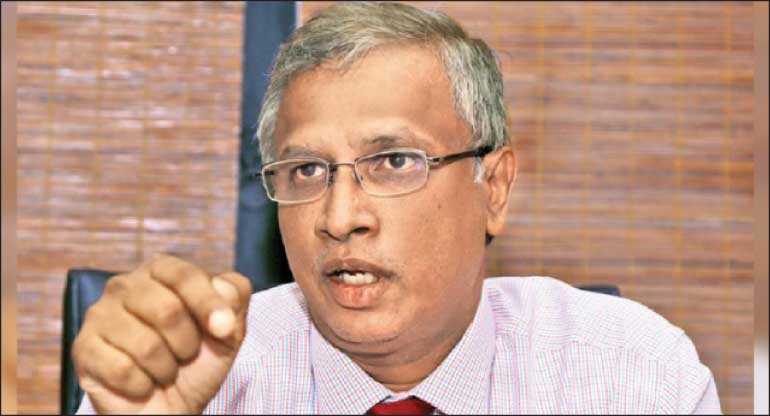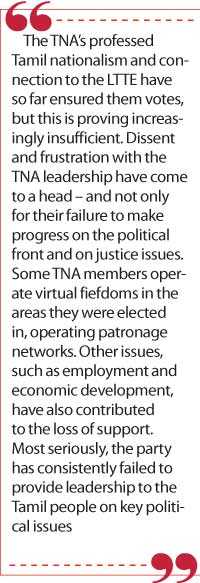Sunday Jan 18, 2026
Sunday Jan 18, 2026
Friday, 5 June 2020 00:00 - - {{hitsCtrl.values.hits}}

TNA Spokesperson M.A. Sumanthiran
A few weeks ago, Tamil news cycles were dominated by coverage of an interview given by the Tamil National Alliance Spokesperson M.A. Sumanthiran to a Sinhala media site. During the course of the interview, he made several comments which created controversy and outrage amongst Tamils. 
The resulting conversation in Sri Lanka’s English-language spaces however failed to discern the actual issues. Instead, commentators opposed to the idea of Tamil nationalism, both Tamil and Sinhala, focused on the “traitorisation” phenomenon in Tamil politics, which predates the war and resulted in the killing of Tamil “moderates” by the LTTE and others.
One writer, a relative of Sumanthiran, even spuriously claimed “traitorisation is running amok again,” comparing the current verbal attacks to a time when so-called “traitors” were hung from lamp-posts and assassinated. The trivialisation of this “traitorisation” issue by many throws doubt on whether they were made due to a genuine desire for Tamil introspection about these issues. Rather the intention appeared to be to use it to attack Tamil nationalism and to paint Sumanthiran as a victim of these “Tamil extremists”.
Those rushing to dump on Tamil nationalism missed (or deliberately ignored) two key dynamics. Firstly, Sumanthiran’s comments in early May didn’t draw this much criticism because they were new and unheard of. Rather, the extent of the backlash and the vitriol was due to senior figures within the TNA using this opportunity to bash him for their own selfish party-political reasons. Indeed, much of the “traitor” language came from within the TNA’s own ranks.
Secondly, Sumanthiran’s clarifications, during which he lauded the LTTE Leader’s and the movement’s sacrifices, were a straightforward reaffirmation of Tamil nationalist politics, intrinsic to the party’s messaging since 2009. This is standard TNA language, wilfully ignored by their loudest defenders in Colombo, who attack and vilify any other Tamil employing similar language.
What did Sumanthiran actually say?
So, what did Sumanthiran actually say to cause the initial ruckus? The Tamil Guardian has provided a convenient translation of his Sinhala interview on its website. Much of the initial Tamil criticism was focused on his comments that he did not support the armed struggle and that he accepted the Sri Lankan Flag and Anthem. To be fair to Sumanthiran, this is consistent with what he has said in the past. Sumanthiran says he is a pacifist and as such does not support any violence. TNA Leader Sampanthan has done similarly – they have both condemned the LTTE’s violent acts in the past and they have raised the Sri Lankan Flag at public events. None of this is new, and this was not controversial within the TNA until fairly recently.
When Sumanthiran still had the support of the TNA stalwarts, including ITAK Leader Maavai Senathirajah, Uthayan proprietor Eswarapatham Saravanapavan and TELO Leader Selvam Adaikkalanathan, this was accepted and worked to the TNA’s advantage in their engagement. The TNA’s core would present a nationalist, pro-Tamil liberation image to the Tamil people, while the leadership would display a more conciliatory stance when engaging with their external audience in Colombo and the international community.
When speaking to Tamil audiences, the TNA has espoused Tamil nationalist principles and aligned themselves with the LTTE continuously after 2009. They went as far as claiming to be the sole representatives of the Tamil people and the LTTE’s rightful heirs during their 2015 election campaign. While Sumanthiran is right when he says that the LTTE did not found the TNA, local TNA officials often claim the TNA was created by Prabhakaran and thus, deserve the Tamil vote. This continued claim of proximity to the LTTE is fundamental to ensuring their ongoing dominance of Tamil politics.
All the while, Sumanthiran and Sampanthan have struck a more contrite tone on the national stage when it came to the LTTE. No doubt this was to some extent genuine, but it also served to defuse criticism from outside that Tamils don’t speak about LTTE crimes enough, allowing both to position themselves as the “moderates”. This two-pronged approach has ensured votes from Tamils on one hand and, in the TNA leadership’s belief, a seat at the table nationally and internationally on the other.
To the TNA’s Colombo audience, Sumanthiran and Sampanthan thus became representative of the “good Tamils”, the “moderates”, who were not driven by the nationalist urges like other Tamils. The “bad Tamils”, who are supposedly limited to a “lunatic fringe”, are variably identified as the diaspora, Gajen Ponnambalam and his TNPF, or the former Chief Minister C.V. Wigneswaran. This view holds that these “bad Tamils” are nationalists and “extremists”, who do not represent the vast majority of the Tamil people, who actually hate the LTTE and what it stood for. 
This claim is justified by pointing towards the TNA’s electoral successes and their supposedly LTTE-critical stance. But although Sumanthiran himself takes part in these vilifications against the “lunatic fringe”, a close look at his and the TNA’s statements and actions actually paints a much more complex picture.
In March, speaking at an event in the north-East, Sumanthiran said no one could question the dedication of the LTTE, who did not fight for themselves but for the people, while calling for reflection on some of their decisions – a statement he has made repeatedly in the past, without backlash.
In response to the uproar in May, Sumanthiran went even further. In a Facebook live interview with Globe Tamil, he said “I never said what the LTTE did was wrong,” and that “no one can undermine their sacrifices.” He said that Prabhakaran struggled not for himself but for the liberation of the Tamil people, and then went as far as saying:
“In the Tamil people’s political history and at a specific time, he is someone who gave everything and fought with the aim of obtaining liberation for Tamil people. Even if I disagree with his methods, his dedication was greater than mine or that of any others. For that we bow our heads and pay our respects.”
While this reverence for Prabhakharan may be surprising to external observers, this is not unusual, neither for Sumanthiran, nor for the TNA. The party has consistently used LTTE imagery during election campaigns and has hosted and spoken at events commemorating the LTTE, including Black Tigers Day. Sumanthiran himself spoke at an event in 2018 commemorating the 1987 hunger strike death of Lt. Col. Thileepan. Leaving the TNA’s countless examples of open support for Tamil Eelam and the LTTE aside, even the Sinhala nationalist SLFP’s Jaffna wing has used LTTE songs during their campaigns. This is an unspoken reality for Tamil politicians – in order to win the majority of votes, you cannot dissociate from Tamil nationalism, and you have to claim at least some proximity to the LTTE and the liberation struggle.
Why did Sumanthiran’s comments result in such vitriol this time?
So why did Sumanthiran’s seemingly-mundane comments result in such vitriol this time? Because internally, the alliance has become fragile.
The TNA’s professed Tamil nationalism and connection to the LTTE have so far ensured them votes, but this is proving increasingly insufficient. Dissent and frustration with the TNA leadership have come to a head – and not only for their failure to make progress on the political front and on justice issues. Some TNA members operate virtual fiefdoms in the areas they were elected in, operating patronage networks. Other issues, such as employment and economic development, have also contributed to the loss of support. Most seriously, the party has consistently failed to provide leadership to the Tamil people on key political issues.
In TNA Leader Sampanthan’s most recent interview, he was asked about the lack of an official statement for 18 May, which is commemorated as Tamil Genocide Day, along with other basic questions about the TNA’s politics and policies. He was unable to satisfactorily answer these, instead lashing out at the interviewer, even shaking his fist at him.
Frustration with the leadership has been growing for years and Sumanthiran’s influence in determining policy is seen as a threat to leadership aspirations by Maavai Senathirajah and his supporters, who see him as the natural successor to Sampanthan. In this context, it is not surprising that much of the rage against Sumanthiran originated from within his alliance. Those who turned on him include PLOTE Leader D. Siddharthan, himself the leader of a formerly anti-LTTE party which is accused of atrocities, and Saravanapavan, who demanded he be removed from the party.
In another video statement, Sumanthiran expresses his profound disappointment with his TNA colleagues, specifically Maavai Senathirajah. According to Sumanthiran, Senathirajah did not even grant him the courtesy of a phone call before condemning him publicly. This treatment by senior TNA stalwarts of Sumanthiran is grossly unfair, however it is difficult to feel much sympathy for Sumanthiran when he himself has engaged in the hypocritical and hysterical “lunatic fringe” mudslinging against other Tamils in the past.
Strategic duplicity on Tamil nationalist principles losing its viability?
Whether this will result in a split in the party remains to be seen – there are certainly many in the Sinhala south who would be delighted at a weakened Eelam Tamil political front. Sampanthan has proven himself as a master tactician in holding the alliance together, however, it is not sustainable that the collaboration of the different Tamil parties is reliant on an octogenarian. And the problems the TNA faces are larger than just the elite discord.
But despite this, if the alliance holds, the TNA may continue to win elections. Its powerful media organisations continue to provide a further nationalist spin. But it is the failure of an alternative that continues to allow the TNA to be successful. The Tamil National People’s Front’s inability to capture the imagination of the Tamil people as a viable alternative is one of the main reasons for the continued hegemony of the alliance amongst Tamils in the north-east. And whenever it does appear that another party might threaten its vote share, the TNA will once again ramp up its time-tested tactic – aligning itself with the LTTE and claiming its mantle.
But the TNA has moderated its political stance in a so far futile attempt at gaining incremental concessions from the Sri Lankan State. Despite this, they appear far from reaching a solution acceptable to the Tamil people.
Repeatedly falling short of its stated goals, while continuing to pay mere lip service to Tamil nationalism, is increasingly hurting the party and trust in its politicians. The recent fallout from Sumanthiran’s comments suggests that strategic duplicity on Tamil nationalist principles may be losing its viability as a long-term strategy.
[The writer is an Advisor for the Washington DC-based People for Equality and Relief in Lanka (PEARL), and a Human Rights Fellow at the Colin Powell School for Civic and Global Leadership.]